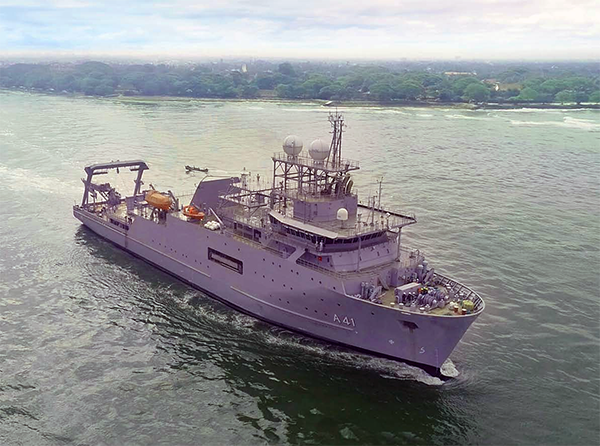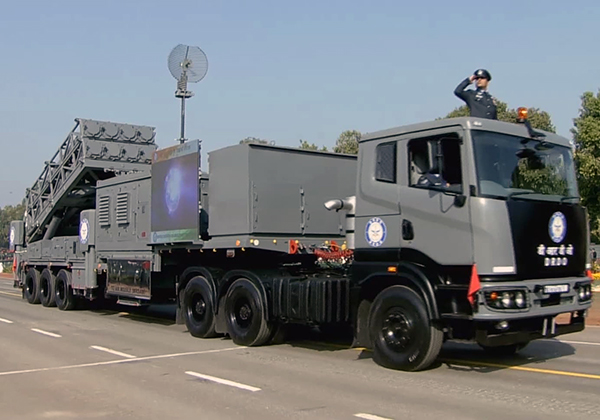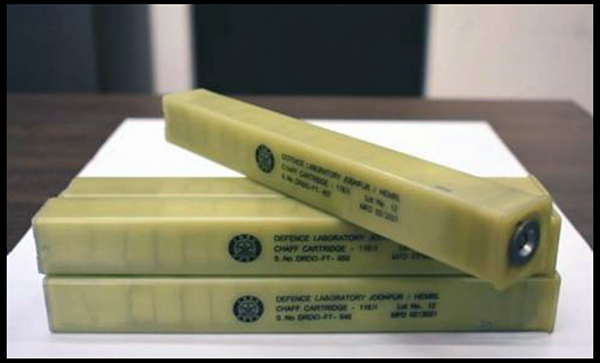DRDO to Develop 6 AEW&C Systems for IAF
The Cabinet Committee on Security (CCS), on 8 September, cleared a nearly Rs 11,000 crore project of the Defence Research and Development Organization (DRDO) to develop six new Airborne Early Warning and Control (AEW&C) aircraft for the Indian Air Force, using Airbus jets bought from Air India.
The IAF inducted its first indigenously developed AEW&C system, mounted on a Brazilian Embraer-145 jet, in February 2017, beefing up its capability to detect enemy aircraft and missiles. The Netra AEW&C system was developed by the DRDO and has a range of around 200 km.
The new AEW&C system, most likely to be mounted on the Airbus A321 aircraft, is expected to be more advanced than the Netra system, the official said. Currently, two Netra systems are in service.
The IAF also operates three Israeli Phalcon airborne warning and control system (AWACS) mounted on Russian IL-76 heavy-lift planes. The system has a range of 400 km. The IAF needs more such systems to cover the eastern and western sectors during offensive operations.
The approval for the new AEW&C jets came at a time when government has sharpened its focus on promoting self-reliance in the defence manufacturing sector and positioning itself as an exporter of military hardware.
AEW&C systems are covered under the ban imposed by the government on the import of 209 defence items that will be implemented progressively from 2021 to 2025.
The AEW&C can detect and track all flying objects in the sky, including incoming fighters, cruise missiles and drones, faster than ground-based radars. They can also act as an aerial control room for missions while also keeping track of ships out at sea.
The criticality of the AEW&C was felt during the aerial duel between India and Pakistan on 27 February 2019.
Pakistan, which has six Saab 2000 early warning aircraft besides four others, had taken advantage of IAF’s changeover of the ‘eye in the sky’, when launching the attack.
Floating Missile Test Range INS Anvesh Ready
Sea trials of India’s first floating missile test range (FTR), INS Anvesh, were set to begin in September with the ship expected to be commissioned November. Built by Cochin Shipyard and designed by the Defence Research and Development Organization (DRDO), the nearly 9000 tonne ship will be used to test missiles up to range of 1500 kilometers deep inside the Indian Ocean without the threat to population or sea traffic as well as land mass limitation.
India is expected to commission at least four ships in 2021 with ballistic missile tracking ship INS Dhruv being handed over to National Research Technical Organization (NTRO) on September 10. Stealth guided missile destroyer INS Vishakapatnam and diesel attack submarine INS Vela, fourth of the Kalvari class, will also be commissioned by the end of the year.
Once commissioned, the FTR INS Anvesh will bring futuristic missile projects up to speed as it will provide for a ready-made safety corridor without going through the tedious exercise of issuing NOTAMs to ships and aircraft flying in the area. While the DRDO missile testing site at Wheeler Island off Odisha is under the scanner of the adversaries, the FTR will also allow discreet testing of missiles and torpedoes 400 to 500 nautical miles into the sea.
While only a select group of nations operate FTRs, the DRDO has specific plans to use the vessel, equipped with electro-optical missile tracking, S-band radar tracking, telemetry devices apart from a launch pad, control and mission control center, for testing its phase II of Ballistic Missile Defence (BMD) interceptor missiles. The phase II of the BMD envisages intercepting and destroying enemy missile up to range of 2000 kilometers by kinetic force with the FTR allowing live testing of the interdictor missiles and not computer simulations.
The FTR will also allow for live missile and torpedo firing by the Navy as well as surface-to-surface tactical missiles with the Indian Army.
DRDO Hands Over MRSAM System to IAF
In a significant boost to India’s defence capabilities, the first deliverable Firing Unit (FU) of the Medium Range Surface to Air Missile (MRSAM) System was handed over to IAF in the presence of defence minister Rajnath Singh at Air Force Station, Jaisalmer in Rajasthan on 9 September 2021. During the event, DRDO and IAI officials demonstrated the capabilities of the MRSAM system, as part of the On-Site Acceptance Test (OSAT).
The MRSAM (IAF) is an advanced network-centric combat Air Defence System developed jointly by the Defence Research and Development Organisation (DRDO) and Israel Aerospace Industries (IAI) in collaboration with the Indian industry comprising of private and public sectors including MSMEs.
The MRSAM system provides point and area air defence for ground assets against a wide range of threats including fighter aircraft, UAVs, helicopters, guided and unguided munitions, sub-sonic & supersonic cruise missiles etc. It is capable of engaging multiple targets at ranges up to 70 km in severe saturation scenarios. The missile is powered by an indigenously developed rocket motor and control system for achieving high manoeuvrability during the terminal phase.
ARCI High Quality Ceramics for TI and Personal Protection
International Advanced Research Centre for Powder Metallurgy and New Materials (ARCI) – an Autonomous Research and Development Centre of Department of Science and Technology (DST), has succeeded in developing high-quality transparent ceramics developed for the first time in India which can be used in thermal imaging and personal protection equipment.
Indian researchers have developed transparent ceramics, reaching theoretical transparency through a technique called colloidal processing followed by simultaneous application of temperature and pressure, for the first time in India, the Ministry of Science & Technology stated.
The material can be used for thermal imaging applications, especially in harsh service conditions and personal protection systems such as, helmets, face shields, and goggles.
Researchers at the ARCI have produced magnesium aluminate spinel ceramics with colloidal processing followed by HIP technique which involves the simultaneous application of temperature and pressure.
Transparent ceramics is a new class of advanced materials with unique transparency and excellent mechanical properties. These materials can be designed not only for transparent to visible light but also for ultraviolet (UV), Infrared (IR), and Radiofrequency (RF), giving the opportunity for diverse applications.
Though produced by different countries globally, transparent ceramics are restricted in supply as they can be used for strategic applications. Though several attempts were made in the country, the transparent ceramics produced were either on a laboratory scale or low transparency. The currently developed process is able to produce the sizes usable for several applications and on a pilot scale.
With potential applications in infantry personal protection systems involving thermal imaging such as helmets, face shields, and goggles, these transparent ceramics developed in India is a step towards Atmanirbhar Bharat.
DRDO Pitches LCA Tejas, Akash Missiles, Arjun Tank at Russian Expo
DRDO participated in week-long international arms exhibition Army 2021 Expo in Moscow from August 22.
The weapons showcased by DRDO included Beyond Visual Range Air-to-Air Missile (BVRAAM) ‘ASTRA’, Anti-Tank Guided Missile (ATGM)-NAG and HELINA, Surface-to-Air Missile (SAM) ‘Akash’, Light Combat Aircraft (LCA)-Tejas, Airborne Early Warning and Control System (AEW&C), Identification of Friend and Foe (IFF) technology, Advanced Towed Artillery Gun System (ATAGS), Joint Venture Protective Carbine (JVPC), Arjun Main Battle Tank MK1A, Rohini Radar, Air Defence Fire Control Radar (ADFCR)-Atulya Radar.
Rosoboronexport is offering India its whole range of small arms and light weapons, including assault rifles, machine guns, sniper rifles, submachine guns, pistols, and grenade launchers.
The Indian Army has apparently shown keen interest in acquiring small arms such as the Kalashnikov AK-100 series, AK-200 series, AK-12, AK-15, and AK-19 assault rifles.
Along with these, KORD assault rifles, sniper rifles as well as machine guns — all manufactured by the Kalashnikov Concern and the Degtyarev Plant, part of the Rostec State Corporation, may also be picked by the Indian Army.
Rostec’s key holdings took part in the Forum: United Aircraft Corporation, Russian Helicopters, High-Precision Weapons, Uralvagonzavod, Techmash, Central Research Institute for Precision Machine Engineering, United Engine Corporation, Concern Radio Electronic Technologies (KRET), Technodinamika, Ruselectronics, Shvabe, and Avtomatika.
DRDO Develops Chaff Technology for Fighters
DRDO, on 19 August, said it had developed an advanced Chaff technology to safeguard the fighter aircraft of the Air Force against hostile radar threats.
“The IAF has started the process of induction of this technology after the completion of successful user trials,” a DRDO statement said. “The technology has been given to the industry for production in large quantities to meet the annual rolling requirement of the IAF,” it stated.
Defence Laboratory, Jodhpur, developed the advanced Chaff material and chaff cartridge-118/I in collaboration with High Energy Materials Research Laboratory (HEMRL), Pune, meeting the qualitative requirements of the IAF.
The DRDO said that in today’s electronic warfare, survivability of fighter aircraft was of prime concern because of advancement in modern radar threats. It explained that their survivability, Counter Measure Dispensing System (CMDS) was used that provides passive jamming against infrared and radar threats.
“Chaff is a critical defence technology used to protect fighter aircraft from hostile radar threats,” it noted, adding that the importance of this technology lay in the fact that very less quantity of chaff material deployed in the air acted as decoy to deflect enemy missiles for ensuring safety of the fighter aircraft.





















